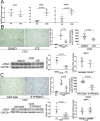Sphingosine-1-phosphate promotes liver fibrosis in metabolic dysfunction-associated steatohepatitis
- PMID: 38753743
- PMCID: PMC11098361
- DOI: 10.1371/journal.pone.0303296
Sphingosine-1-phosphate promotes liver fibrosis in metabolic dysfunction-associated steatohepatitis
Abstract
Aim: Metabolic dysfunction-associated steatohepatitis (MASH) is one of the most prevalent liver diseases and is characterized by steatosis and the accumulation of bioactive lipids. This study aims to understand the specific lipid species responsible for the progression of liver fibrosis in MASH.
Methods: Changes in bioactive lipid levels were examined in the livers of MASH mice fed a choline-deficient diet (CDD). Additionally, sphingosine kinase (SphK)1 mRNA, which generates sphingosine 1 phosphate (S1P), was examined in the livers of patients with MASH.
Results: CDD induced MASH and liver fibrosis were accompanied by elevated levels of S1P and increased expression of SphK1 in capillarized liver sinusoidal endothelial cells (LSECs) in mice. SphK1 mRNA also increased in the livers of patients with MASH. Treatment of primary cultured mouse hepatic stellate cells (HSCs) with S1P stimulated their activation, which was mitigated by the S1P receptor (S1PR)2 inhibitor, JTE013. The inhibition of S1PR2 or its knockout in mice suppressed liver fibrosis without reducing steatosis or hepatocellular damage.
Conclusion: S1P level is increased in MASH livers and contributes to liver fibrosis via S1PR2.
Copyright: © 2024 Osawa et al. This is an open access article distributed under the terms of the Creative Commons Attribution License, which permits unrestricted use, distribution, and reproduction in any medium, provided the original author and source are credited.
Conflict of interest statement
Tatsuya Kanto has personal financial interests from Gilead Sciences for Lecture fees. Hideo Shindou was collaborated with ONO Pharmaceutical company, but the collaboration is not related to this manuscript. This does not alter our adherence to PLOS ONE policies on sharing data and materials.
Figures



References
-
- Angulo P, Kleiner DE, Dam-Larsen S, Adams LA, Bjornsson ES, Charatcharoenwitthaya P, et al.. Liver Fibrosis, but No Other Histologic Features, Is Associated With Long-term Outcomes of Patients With Nonalcoholic Fatty Liver Disease. Gastroenterology. 2015; 149(2): 389–397.e310. doi: 10.1053/j.gastro.2015.04.043 . - DOI - PMC - PubMed
MeSH terms
Substances
LinkOut - more resources
Full Text Sources
Medical

